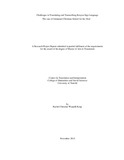| dc.description.abstract | This study set out to investigate challenges in translating and transcribing Kenyan Sign
Language. There is not much translation in Kenyan Sign Language (KSL) because it is
considered a visual language and it is relatively new in Kenya, hardly seven decades. This
study involved the collection of material translated to KSL, deleting any English language
inscriptions written thereon, and having the material translated back to KSL by Standard
Eight pupils from Immanuel Christian School for the Deaf, and their KSL and English
teachers. The study had the objective of investigating challenges of equivalence in KSL
translations as well as any strategies employed to solve such challenges of equivalence in
translating KSL.
The study employed the theory of equivalence developed by Nida and elaborated further
by Nida and Taber (1982:12) which posits that “Translating consists in reproducing in the
receptor language the closest natural equivalent of the source language message, first in
terms of meaning and secondly in terms of style”; which goes further to point to closest
natural equivalence, basic communication based on the unity of human beings, and a first
level of meaning.
The study was initiated by browsing the internet for material on Sign Language translation
in general and Kenyan Sign Language translation in particular. Thereafter, visits were
made to various institutions to collect material translated into KSL. The study also utilized
a glossary of Parliamentary and global discourse which had been translated to KSL in
graphics for another study on KSL interpreting of the proceedings of the Kenya National
Assembly. Though the study on KSL interpreting of the proceedings of the Kenya
National Assembly used the glossary in English, it did not require the graphics in KSL.
These, therefore, formed part of the material for translation by the informants. This was
followed by designing two questionnaires entitled “Student Questionnaire” and “Teacher
Questionnaire” which sought background information on the pupils and the teachers.
When the material was ready, the researcher travelled to Immanuel Christian School for
the Deaf in Homa Bay County, for face-to-face interviews, translations and completion of
the personal questionnaires. An analysis has been made of the translations and of the
biodata. | en_US |

